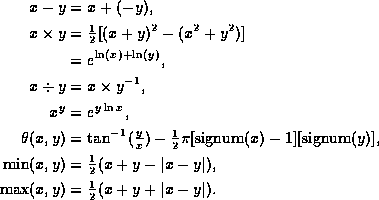Unary functions have been discussed fully, so we now turn our
attention to binary functions. There are several ways of
extending the methods presented to handle binary functions.
The timely evaluation of arbitrary binary functions is
difficult,
so we will first list the binary functions that interest us.
These functions are: x+y, x-y, ![]() ,
, ![]() ,
, ![]() ,
,
![]() ,
, ![]() , and
, and ![]() ;
we may later refer to these as the common binary functions.
We consider the exponential function,
;
we may later refer to these as the common binary functions.
We consider the exponential function, ![]() , for positive bases only:
, for positive bases only:
![]() .
The function
.
The function ![]() gives the angle
from the origin to the point (x,y):
gives the angle
from the origin to the point (x,y):
![]()
The functions of interest may be rewritten, as follows:

The addition operator is the sole remaining binary operator. Interval evaluation using the above rules for the binary operators will not produce optimal results. However, a cursory implementation of an interval arithmetic may use the above rules. It is reasonable to rewrite division, since the result will be nearly optimal, with a simpler implemention. Rewriting may expose salient features to a symbolic optimizer.
Argument reduction may be performed. For example, we may consider multiplication for positive multiplicands only, by exploiting the following identity:
![]()
| Jeff Tupper | March 1996 |